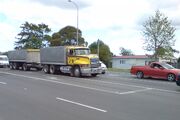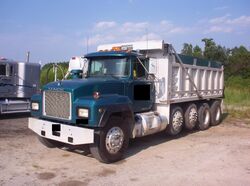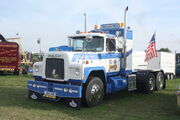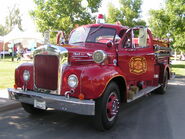 | |
| Type | Subsidiary of AB Volvo since 2001 |
|---|---|
| Founded | 1900 |
| Headquarters |
Allentown, Pennsylvania United States |
| Key people | Dennis Slagle (CEO) [1] |
| Industry | Manufacturing |
| Products | Trucks |
| Employees | 5,037 (2005) |
| Parent | AB Volvo |
| Website | www.macktrucks.com |

Line of 3 Mack recovery trucks of various sizes at Driffield show 2008
Mack Trucks is an American manufacturer of medium & heavy trucks. The company is currently a subsidiary of Volvo Truck. The company's headquarters are located in Allentown, Pennsylvania, United States, in the Lehigh Valley.
History[]
| This article may require cleanup to meet Tractor Wiki's quality standards. (Consider using more specific cleanup instructions.) Please help improve this article if you can. The talk page may contain suggestions. |
Corporation timeline[]
This is a timeline of Mack Trucks history. Most of the information is taken from the Mack History page at MackTrucks.com, unless otherwise noted.[2]

Mack truck used to carry ore at the Acosta Mine Museum in Real del Monte, Hidalgo State, Mexico.
- 1890: John M. Mack gets a job at Fallesen & Berry, a carriage and wagon company in Brooklyn, New York.
- 1893: Mack and his brother, Augustus F. Mack, buy the company John worked for.
- 1894: A third Mack brother, William C. Mack, joins his brothers in the company's operations. The Macks try working with steam powered and electric motor cars.
- 1900s: Inspired by Orville and Wilbur Wright, Willis Carrier and Henry Ford's inventions, John Mack has a vision, dreaming about producing heavy duty trucks and engines.
- 1900: The Macks open their first bus manufacturing plant. The Mack bus, ordered by a sightseeing company, is delivered.
- 1902: The Mack Brothers Company established in New York.
- 1904: The company introduces the name Manhattan on its products.
- 1905: Allentown selected as the home of main manufacturing operations, and headquarters. A fourth Mack brother, Joseph Mack, becomes a stockholder. Mack begins to make rail cars and locomotives.
- 1910: The Manhattan name changed; from now on, the trucks are known as Mack Trucks. Charles Mack, a fifth Mack brother, joins the company.
- 1911: The Saurer Motor Truck Company, headed by C.P. Coleman, had the rights to manufacture and sell heavy trucks under the Saurer brand name at its plant in Plainfield, New Jersey. On September 23, 1911, the Saurer Motor Truck Company merged with the Mack Brothers Motor Car Company of Allentown, headed by J. M. Mack, to form the International Motor Truck Company (IMTC). IMTC would continue to make and sell trucks using the Saurer name until 1918. The capitalization of IMTC was $2.6 million total ($1.6m for Saurer, or 61.5%, and $1.0m for Mack Brothers).[3]
- 1912: Brothers John and Joseph Mack leave.
- 1919: The United States Army conducts a trans-continental project using Mack Trucks to study the need for national highway systems.
- 1922: The company name is changed to Mack Trucks, Inc. The bulldog is accepted as the company's corporate symbol.
- 1924: Jack Mack dies in a car crash in Weatherly, Pennsylvania.
- 1933: Mack Trucks helps in the building of many American structures, including the Hoover Dam.
- 1956: Mack Trucks, Inc. buys Brockway Motor Company. (Brockway ceases in 1977)
- 1966: Mack begins production at its assembly plant in Oakville, Ontario, Canada. The facility closed in 1993.
- 1967: Mack Trucks becomes a part of the Signal Oil and Gas Company. Later that year Signal changes its name to The Signal Companies, Inc.
- 1970: Mack moves into its new Allentown world headquarters.
- 1979: Renault buys 10% of Mack Trucks, Inc.
- 1982: Renault increases ownership stake to 20%, Signal lowers its stake to 10%.
- 1983: Mack Trucks does a 15.7 million share IPO of common stock. Renault increases holdings to 40%, while Signal reduces its stake to 10.3%.
- 1987: Renault reorganizes; Renault Véhicules Industriels buys Renault's Mack shares.
- 1990: Mack Trucks become a wholly owned subsidiary of Renault Véhicules Industriels
- 2001: Mack together with Renault Véhicules Industriels becomes part of Volvo AB of Sweden, the parent company Renault S. A. receives a 20% stake in the combined company. (In 2002 Renault Véhicules Industriels changes its name to Renault Trucks.)
- 2006: Mack has a record sale year.
- 2008: Mack announces relocation of corporate headquarters to Greensboro, North Carolina.[4]
Operations[]
Currently, the company's primary manufacturing facilities are located at the Macungie Assembly Operations plant in Macungie, Pennsylvania, and at their New River Valley Assembly Operations in Dublin, Virginia. Mack Trucks is a top producer in the vocational, on-road-vehicle market, Class 8 through Class 13. It is also the most popular manufacturer of heavy-duty off-road trucks in America. The company's distinctive logo, a chrome-plated (sometimes gold-plated) bulldog, can be found on the front of almost all Mack trucks.
Mack trucks have been sold in 45 countries. The Macungie, Pennsylvania, manufacturing plant, located close to its Allentown headquarters, produces the Mack Granite, LE, and MR models, including the construction and refuse series products. In Dublin, Virginia, the Pinnacle and CH highway models are made at the New River Valley assembly plant. Engines, the Maxitorque ES T300 series transmissions, the TC-15 transfer cases, and rear engine power take-offs are designed and manufactured in Hagerstown, Maryland, which, according to local historians, was the original factory location.
Parts for Mack’s right-hand-drive vehicles are produced in Brisbane, Queensland, Australia, for worldwide distribution. Assembly for South America is done at Mack de Venezuela C.A., in Caracas, Venezuela. The Venezuela operation is a complete knock down (CKD) assembly facility. Components are shipped from the United States to Caracas, and the plant then does final assembly.
In addition to its Macungie manufacturing facility, Mack also has a re-manufacturing centre in Middletown, Pennsylvania where it takes used parts and refurbishes them for resale/reuse.
2008 Restructuring Plan[]
On August 14, 2008, Mack Trucks announced a major restructuring plan that includes:[4]
- Relocation of Mack's head office, product development, most support functions, and purchasing functions to Greensboro, North Carolina in 2009.
- Assembly of all produced Mack highway vehicle in Macungie, Pennsylvania from 2008.
- Mack's testing facility in Allentown, Pennsylvania, will be converted into a "customer demonstration/reception centre" in 2010.
- Restructuring the parts distribution network by 2010.
- Now delayed to 1st quarter 2011
Market, model and products timeline[]
This is a timeline of Mack Trucks history. Most of the information is taken from the Mack History page at MackTrucks.com, unless otherwise noted.[2]
- 1909: A junior model 1-1/2 ton truck is introduced.
- 1910: Mack delivers the first motorized hook and ladder firetruck used by the city of Morristown, New Jersey.
- 1914: The Mack ABs are introduced.
- 1916: The Mack ACs are introduced. Ultimately, over 40,000 of these models are sold.
- World War I: Mack delivers over 6,000 trucks, both to the United States and Britain's military. A legend surfaces that British soldiers would call for Mack Bulldogs to be sent when facing adversity.
- 1918: Mack becomes the first manufacturer to fit air cleaners and oil filters to their trucks.[citation (source) needed]
- 1920: Mack Trucks are the first with power brakes on their trucks.
- 1922: International Motors Company develops gasoline-driven passenger railcar for the New York, New Haven and Hartford Railroad. A standard passenger railcar on top of a standard motor truck chassis, seating between 36 to 50 passengers, at a cost of $16,500. The car operates in a ten-mile (16 km) stretch between New Haven, and Derby, Connecticut.[5]
- 1927: Mack's BJ and BB models built.
- 1932: The Bulldog starts to travel on the hoods of Mack trucks.
- 1936: The Mack E series introduced. Mack Jr trucks introduced.
- 1938: Mack trucks is the first company to produce its own heavy-duty diesel engines.
- World War II: Mack trucks were used by the military in various capacities, and the company built many heavy-duty trucks to help the allied forces win the day. From 1941 to 1945, the combined armed forces of the United States, Great Britain, France, and Canada took delivery of 35,096 total vehicles. The combat "N Series" (NB, NJU, NM, NO, NR, etc.) accounted for 26,965 of the total. Commercial type vehicles including: trucks, off-highway, fire-trucks, trailers, and buses, accounted for the rest. A total of 2,053 NO models alone were produced from 1940 to 1945. The 6x6 7-yard/2-ton NO was the most important specifically military model, and could be used as a transport or tractor for the 155 mm Long Tom field gun. Mack also built over 2600 power trains for tanks. The Allentown bus plant (5C) built Vultee PBY Catalina flying boats as well as components for the BT-13 Valiant Trainer and B-24 Liberator Bombers. More than 700 NJU (5-to-6 ton 4x4) models were in the hands of the U.S. Army by 1942. In 1939 & 1940 the French and British received several hundred NR4 and EXBU models.
- 1950: The Mack A Model series of trucks is introduced, produced until 1953.
- 1953: The Mack B Model series of trucks is introduced. 127,786 produced until 1966.
- 1955: The Mack D Model low cab forward city delivery truck entered the market. Access to the engine compartment was possible by the Verti-lift cab. The cab lifted straight up hydraulically, guided by a forklift style mast behind the cab. Two styles of D Models were produced, the first styling had a square grille and no dress up trim. It was produced in 1955 and early 1956. The second styling included a styled grille, cab rear corner windows and stylish emblems and trim. The second styling was build from mid 1956 until the end of the D Model in 1958. A total of 832 D Model Mack Trucks were produced from 1955 until 1958.
- 1956: City of Hamilton, Bermuda buys first diesel-power fire truck (B85F).
- 1959: The first aluminium riveted construction COE (cab-over-engine) family of trucks is introduced: The Mack G Model which had a short production due to a striking resemblance to the Kenworth COE and Mack having the F Model ready for production.[citation (source) needed] A total of 2181 G Model Mack Trucks were produced from 1959 until 1962.
- 1962: The Second of the COE (cab-over-engine) family of trucks is introduced: The Mack F Model all steel sleeper (FL) or non sleeper (F) is the first of this family of models for Mack.
- 1965: Mack releases the Super Pumper System, to be used by the New York City fire department. It would help put out 2,200 fires.
- 1965: The R Model Series introduced, to replace the B Model Series.
- 1966: The RL (for R-Western) model built at Hayward, California until 1981.
- 1969: Mack patents the cab air suspension.[citation (source) needed]
- 1975: Macungie plant opens, build the Cruise-Liner series until 1983.
- 1977: Super-Liner introduced, production runs for 15-years until 1993.
- 1978: Introduction of the low-cab-forward urban MC/MR series.
- 1979: Medium-duty model Mid-Liner introduced, built by Renault Véhicules Industriels in France
- 1982: Production of the MH Ultra-Liner model begins.
- 1988: Mack introduces the CH series for highway applications.
- 1989: E7 engine replaces E6 engine
- 1990: The R Model was in production until 1990. The RB and RD remained in production after that until being replaced by the Granite.
- 1994: Mack introduces the LE (low entry) refuse vehicle.
- 1998: Electronic Unit Pump (EUP) replaces electronic fuel injection pump
- 1999: A new premium highway tractor is introduced: the "Vision by Mack".
- 2001: Medium-duty Freedom series introduced (built by Renault Trucks in France like its predecessor, the Mid-Liner series).
- 2001: Granite series for construction applications introduced.
- 2003: Mack pulls out of the medium-duty market and discontinues the Freedom series.
- 2005: Mack stops producing the DM model, the last Mack that used the R-Model cab, the RB was also discontinued at the beginning of 2005. In some countries the DM is the most popular truck for construction use.
- 2006: Introduction of Pinnacle highway vehicle it is which was the replacement for the Vision highway product.
- 2007: A new product line is introduced to include Models LEU and MRU amongst others.
- 2007: Introduction of US07 compliant engines in all of its trucks.[citation (source) needed]
- 2008: In March Titan was introduced. A HD duty model with the 16-liter big-block MP10, the largest ever 6-cylinder engine from Mack, with 515, 565, and 605 horsepower (451 kW) models.[6][7]
Products[]
Current models[]
North America[]
- Construction Series:
- Granite
- Granite Axle Back
- TerraPro Cabover
- Granite
- Heavy Duty:
- Highway Series:
- Pinnacle:
- Pinnacle Sleepers
- Pinnacle Axle Forward
- Pinnacle DayCab
- Pinnacle Rawhide
- Smartway
- Pinnacle:
- Refuse Series:
- TerraPro Cabover
- TerraPro Low Entry
- Granite Axle Back
- Granite
- Military:
- Granite Armored Line Haul
Australia, New Zealand, & South Africa[]

Mack CH-model in Henderson, New Zealand
- List of current models produced for the Australian, New Zealand, and South African market at the Wacol, Queensland factory.[10][11]
- Granite
- Metro-Liner
- Super-Liner
- Titan
- Trident
- Trident Axle Forward
- Trident Axle Back
Fire apparatus products[]
Mack Trucks produced fire apparatuses from 1911 until 1990.[12] Despite the abrupt shutdown of their production, many apparatuses have been refurbished and still serve with various fire departments throughout the world.
Some examples of Mack fire apparatus:
- MC611F12 pumper
- MR686P aerial trucks
- MR686S 90' Bronto aerial truck
- MR690S 100 aerial truck
- MR688P pumper
- MS Midliner pumper
- CF-611 series cab-forward apparatus
- CF-700 series attack engine
Fire apparatus gallery[]
R/RB, U, RD, DM-Models[]
| This section does not cite any references or sources. Please help improve this article by adding citations to reliable sources. Unverifiable material may be challenged and removed. (June 2008) |

1998 Mack RD688 dump truck with additional lifting tag axles
Mack started to produce the R and U Model in the early 1960s, for highway use, and the RD and DM Models for construction use. The 4 models featured the same cab, the U and DM had the cab offset to the left, and the early RD and DM had 3-piece steel hoods. They later had 1-piece hoods, the RD had a new hood and the DM the U hood. In the late 1980s, the R and U Models were discontinued, the RB was introduced, mostly for severe-duty applications it is, and the hood was slightly modified.
2002 was the last year for the RD, and 2005 for the RB and DM, the DM being the last one to be discontinued, it was the last model to use this cab, and the last model of this family that was produced. As a replacement for the construction models, Mack started to offer the Granite, Granite Bridge-Formula and Granite Axle-back, however, they feature a centered cab, and which is not offset like the DM.
Maxidyne engine[]
In the early 1960s, Mack Truck's executive vice president of product and engineering, Walter May, developed the Maxidyne high-torque rise engine. The engine was first available in the 1968 model year trucks. This was an industry-changing event. The Maxidyne allowed a heavy Class 8 truck to be operated with a 5 speed (Maxitorque) transmission. Previously, heavy trucks were typically equipped with 10 or more gears.
Other products[]
- MP Engine Series
Trademark[]
The company's trademark is the Bulldog. Mack trucks earned this nickname in 1917, during World War I, when the British government purchased the Mack AC model to supply its front lines with troops, food and equipment. British soldiers dubbed the truck the "Bulldog Mack", because they said it had "the tenacity of a bulldog." Its pugnacious, blunt-nosed hood, coupled with its incredible durability, reminded the soldiers of the tenacious qualities of their country's mascot, the British Bulldog.[13][14]
The logo was first used in 1921 for the AB chain drive models and made the official corporate logo in 1922.[15]
Leadership[]
This is a list of the highest ranking executive officer of Mack Trucks since its inception:
| Mack Leader | Dates of service |
|---|---|
| John M. Mack | 1900 to 1905 and 1909 to October 17, 1911 |
| Otto Mears | April 29, 1905 to January 9, 1906 |
| Jacob Sulzbach | January 9, 1906 to January 8, 1907 |
| Thomas Rush | January 8, 1907 to December 8, 1908 |
| Charles P. Coleman | October 17, 1911 to June 13, 1913 |
| John Calder | June to October 1913 |
| Vernon Munroe | October 22, 1913 to May 23, 1917 |
| Alfred J. Brosseau | May 15, 1917 to September 24, 1936 |
| Emil C. Fink | January 28, 1937 to January 1, 1943 |
| Charles T. Ruhf | August 5, 1943 to June 6, 1949 |
| Edwin D. Bransome | June 6, 1949 to January 11, 1955 |
| Peter O. Peterson | January 11, 1955 to December 31, 1958 |
| Christian A. Johnson | 1958 to 1962 (Acting President) |
| Nicholas Dykstra | July 20, 1961 to September 1, 1962 |
| C. Rhoades McBride | September 7, 1962 to January 6, 1965 |
| Zenon C.R. Hansen | January 7, 1965 to January 28, 1972 |
| Henry J. Nave | January 28, 1972 to January 1, 1976 |
| Alfred W. Pelletier | January 1, 1976 to July 21, 1980 |
| John B. Curcio | July 21, 1980 to 1989 |
| Ralph Reins | 1989 to 1990 |
| Elios Pascual | 1990 to 1995 |
| Pierre Jocou | March 1, 1995 to November 29, 1996 |
| Michel Gigou | December 1, 1996 to July 1, 2001 |
| Paul Vikner | July 1, 2001 to April 1, 2008 |
| Dennis Slagle | April 1, 2008 to Present |
In Popular Culture[]
Throughout episodes of King of the Hill, Dale is seen wearing a hat with the Mack Trucks logo on it.
Joan Crawford, a song by rock band Blue Oyster Cult, contains a reference to Mack Trucks.
A black and silver Mack Cement Truck will be used as the alternate mode of the Decepticon Mixmaster in the 2009 film Transformers: Revenge of the Fallen.
Model range[]

A customised Mack in the UK at the Pickering Steam Rally 2009
Mack trucks are not normally imported into the UK and any that are here are individual imports, other than ex-army models from world war 2 when thw American forces brought large numbers over. After the war they were left behind or sold off as surplus.
Preserved models in the UK[]
- A number of the military ones are in collections and appear at Vintage vehicle, transport shows and Military vehicle events.
- Civilian models have been imported by recovery operators and collectors looking for something different. A few of these appear at Commercial and historic vehicle shows & rallies. (photo above)
See also[]
- Volvo
- Commercial vehicles
- Heavy Haulage Contractors
- Heavy Haulage
- List of Engine Manufacturers
- List of Mack Trucks Products
References[]
- Original Article expanded with the Wikipedia:Mack article for the history and time line details.
- ↑ Press Release: "Slagle Named Mack President & CEO". - Mack Trucks. - January 15, 2008
- ↑ 2.0 2.1 Mack History - Mack Trucks.com Official Website
- ↑ "Motor Truck Merger". - New York Times. - September 23, 1911. - p.15. - Retrieved: 2008-06-16
- ↑ 4.0 4.1 News/Events: Mack Plans Restructuring to Increase Competitiveness, Secure Long-Term Leadership Position. - News Releases 2008. - Mack Trucks. - August 14, 2008. - Retrieved: 2008-08-15
- ↑ "Railroads Cut Off Short Branch Lines". - New York Times. - January 15, 1922. - p.102
- ↑ "Mack to Launch its Biggest Model -- TITAN": Bulldog. - 2008-Volume 1. - p.9. - (Adobe Acrobat *.PDF document). - Retrieved: 2008-06-02
- ↑ Product Brochure: Titan. - Mack Trucks. - (Adobe Acrobat *.PDF document). - Retrieved: 2008-06-02
- ↑ Mack Bulldog Line. - Mack Trucks. - (Adobe Acrobat *.PDF document). - Retrieved: 2008-06-08
- ↑ Products. - Mack Trucks. - Retrieved: 2008-06-08
- ↑ New Breed Range. - Mack Trucks Australia. - Retrieved: 2008-06-08
- ↑ Hill, Liezel. - "Volvo, Mack team up for SA market". - Engineering News. - July 27, 2005. - Retrieved: 2008-06-08
- ↑ "Cape Cod Fire Department:Mack Fire Apparatus". Retrieved on 2006-10-04.
- ↑ History: 1910-1919. - Mack Trucks. - Retrieved: 2008-06-08
- ↑ "Mack Trucks, Inc. Company Overview". - Volvo Group. - (Adobe Acrobat *.PDF document). - Retrieved: 2006-10-31
- ↑ History: 1920-1929. - Mack Trucks. - Retrieved: 2008-06-08
External links[]
- Mack Trucks Official Web Site
- BigMackTrucks.com - Antique, Classic & Modern Mack Truck Support Forum
- Mack Truck Pictures (Hank's Truck Pictures)
- Mack Trucks Group Images On Flickr
| Mack Trucks v • t • e | ||||
|---|---|---|---|---|
| ||||
| ||||||||||||||||||||||||||
| This page uses some content from Wikipedia. The original article was at Mack Trucks. The list of authors can be seen in the page history. As with Tractor & Construction Plant Wiki, the text of Wikipedia is available under the Creative Commons by Attribution License and/or GNU Free Documentation License. Please check page history for when the original article was copied to Wikia |





